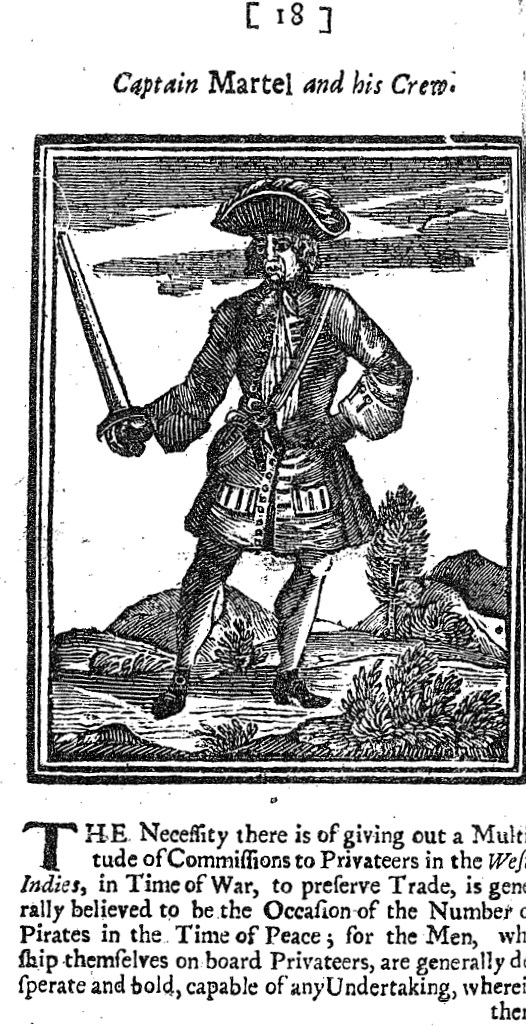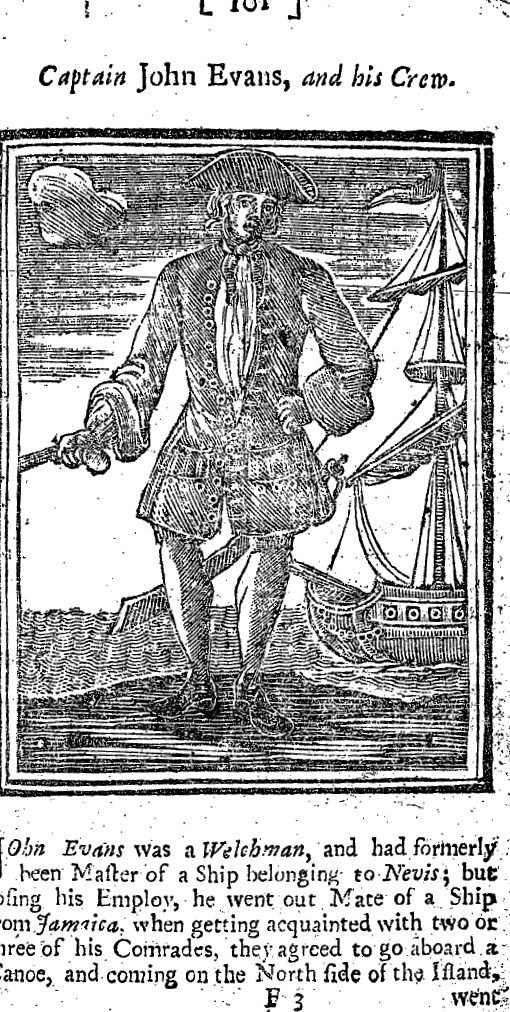-
Posts
703 -
Joined
-
Last visited
Content Type
Profiles
Forums
Events
Gallery
Posts posted by PoD
-
-
There is a paragraph in the 1729 edition of the spectator that seemed to say that the hats the navy were using were long out of date:
"We hear from good authority, that it is the intention of the Admiralty to revise the present regulation for the uniform of the Royal Navy, with the view of reducing the costly expenditure of the junior officers. It is said that epaulettes are to be altogether abolished, and it is a question whether the antiquated cocked-hat will be retained for use on board ship.— United Service Gazette. . "
-
Well speaking for myself, what I was seeing was a basic wide brimmed circular hat pinned up at the front and back.
Maybe the artist was just rubbish at perspective and they are tricorns

The hat shown in this picture above looks to me a lot like the one that was featured in the Captain Kidd exhibit:


-
Would they maybe what was refered to as a cocked hat then? Or are we saying that is another word for Tricorns?
-
Will at Kings Forge and Muzzleloading can make new stocks for your pistols or muskets
-
Does anyone else see similarities between circa 1725 picture of Capt. Martel and picture of "English admiral at sea" from 1703. E.g both have hat backwards....


This is also has dit similar. I wonder that it maybe that illustrator used naval officer as role models. His hat also can be backwards but it is so clear.

I'd always assumed that these were wearing Bicorne hats. The "English admiral at sea" especially as he even has the smaller brim at the front and the larger brim at the back that was specifically the way that the English made Bicorne hats.
-
Late 17th century illustration of firepots


I used these pictures when I was researching the Firepots I made. They provided the missing information on how the thing was thrown and what held the wooden top in place.

-
I just won one of the tables on ebay for £20 ($35). It hasnt got a drawer in it but I am sure I can make one and fit it in.


-
I never noticed that before but yes it could well be the same table. I have seen chairs similar to that too.
They are known as Queen Anne style chairs and you can come across modern reproductions quite easily.

Looking closely at the picture of the chair under the dog it seems to have a cane work or rattan style seat rather than the cushioned leather or fabric seats that are more common. This one from a later period has a similar seat configuration:

You can actually buy modern folding versions of the Queen Anne chairs :


http://furniturefort.com/Chairs/Queen-Anne-Folding-Chair.php
-
They come up on ebay now and then for next to nothing but they are always collection only and always way to far away to collect. I missed one in Liverpool last year because I was saving for a boat which I didnt win in the end either.
-
Another great example of early ships furniture is the officers chest found aboard the 1676 wreck of the Swedish ship Kronan


http://www.kalmarlan...art_art-s1/1649
The first picture seems to show one of the large hinged door panels that would have closed to hold all the drawers in place when in transit. (I used to own a similar tool makers cabinet but much larger).
-
Don't forget that the ships tables had a single drawer in it too. A lot of the modern ones don't come with that option.
The originals were made of Oak and had a Deal(?) wood top
-
In the book "The Restoration Warship" by Richard Endsor there is a picture of a gateleg style oval table like the one pictured below that was recovered from the wreck of the Stirling Castle that sank in 1703. It belonged to the Gunner and was one of a number that were issued to the officers and high ranking members of the crew. There is a 1690 contract with Henry Ward from the Navy that mentions tables such as these being supplied to the boat yards in Chatham, UK (Interestingly the same guy also made 20 Hencoops).

-
Thanks William. I've been wanting to reproduce one of these for a while and now being involved in a large pirate display at the Royal Armouries next year I had the excuse to get some made up. I'd love to actually get one made up for real and see just how effective they were. I might try and convince the Armouries to film a live test for the display.
-
Firepots were ceramic pots that were filled with oil or gun powder and topped with a wooden fuse. Around the outside of the pot were loops or “ears” that slow match was tied to.
The pot was thrown onto enemy ships or fortifications using a lanyard (also tied to the ears or onto the rim of the pot). On impact with a hard surface the pot could crack spilling out the contents that was then ignited by the slow match. If the pot failed to smash then the fuse in the top would ignite the contents. Some firepots even contained a Grenadoe that would be lit when the pots contents ignited
This is an inert replica of the firepots found aboard the La Belle shipwreck which sank in 1686.
The Original:


My Replica:

I comissioned the pots to be recreated to the exact dimensions of the La Belle artifacts by a friend that specialises in recreating historically accurate ceramics. The rope is hemp and the ears hold actual slow match. The stopper is wood and holds a removable wooden fuse filled with fake black powder. The top is held on by a circle of calico canvas finished to look like it has been tarred.
http://www.lettersofmarque.co.uk/index.php?main_page=product_info&cPath=13&products_id=204
-
Just found a great book while looking through Google books:
Nauticum astrologicum: or, The astrological seaman: directing merchants, mariners, captains of ships, ensurers, &c. how (by God's blessing) they may escape divers dangers which commonly happen in the ocean. Unto which is added a diary of the weather for XXI years together, exactly observed in London, with sundry observations thereon by John Gadbury (1710)
-
ha ha they are on the to-do list so I will post about them once they are made
-
We are now doing Traverse Boards and Chip Logs for the Discerning Navigator:

http://www.lettersofmarque.co.uk/index.php?main_page=index&cPath=11
-
alas Mr Welsh has now taken the kings pardon and retired from piracy to become a humble Blacksmith at Little Woodham historical village (http://www.littlewoodham.org.uk/).
-
I'm selling this antique Queen Anne Priming horn from my own collection. Perfect for early to mid 1700s reenactment.


This is an original Queen Anne style priming flask from the early 18th century. This would have been used mainly with pistols and carried in the pocket of a waistcoat.
There is a slight crack in the screw on cap and there is some wear to the bottom of the horn but other than that this is a fine example of these rare and collectable powder flasks.
It is approx 3" wide and 6" tall.
$179.27 (these are on some websites for over $400)
http://www.lettersofmarque.co.uk/index.php?main_page=product_info&cPath=5&products_id=197
-
you just have to be careful when using that book as a reference as it's been known to expand on the truth somewhat so cross reference anything if you can.
-
yep it is
-
I've got a gunners level and gunners calipers in my own collection. I also have a French Sector that was apparently used for gunnery calculations.
I had one of the gunners levels in my shop but unfortunately it sold pretty much immediately. I will keep my eye out for another and let you know if I get one.
I should have some wooden gunners tools up in my shop soon though
-
I found this example of a loan agreement form from 1691 and after a little research found out that the form was created in the mid 1680s

BRADFORD, William (printer). Partly-printed loan certificate, accomplished in manuscript, binding Weckhard Livering of Germantown to Thomas Hill for £20.
[Philadelphia: William Bradford, c.1686-1690]. 1 p., small folio (295 x 185 mm). Signed by Livering with his mark, signed by three witnesses Arnoh Cassell, John Griffith and Thomas Herris. Docketing on verso. On watermarked laid paper. Condition: staining, separations at folds, tears with minor losses. among the earliest examples of printing in the middle colonies. "Born in the parish of Barwell, Leicestershire, on May 20, 1663, of humble folk of the Established Church, [William Bradford] first came into notice as the apprentice of Andrew Sowle, the principal London Quaker publisher of his day, and a proselyte to his master's religion" (Hildeburn, Sketches of Printers and Printing). He made his first visit to America in company with William Penn in the fall of 1682. He returned to England, and in 1685 came back to Pennsylvania with a printing press and a recommendation from George Fox to the Quakers of Philadelphia. He set up the first press in the Middle Colonies in 1685, and remained active in Philadelphia until, by siding with George Keith in a controversy with the Friends' Meeting, he jeopardized his printing privileges and moved to New York in the spring of 1693. The "first fruit" from Bradford's Philadelphia press was an almanac for the year 1686 titled Kalendarium Pennsilvaniense published in December 1685. That work included a notice "to the Readers" by Bradford concerning the establishment of his press and apologizing for typographical errors. Also included in that statement is the following annoucement concerning this partly-printed bond: "As for the ease of Clerks, Scriveners, &c. I propose to print blank Bills, Bonds, Letters of Attourney, Indentures, Warrants, &c. and what else presents itself, wherein I shall be ready to serve you." Thus, this form was likely printed by Bradford between 1686 and 1691. Indeed, it could be argued that the printing of this form precedes 1690, as if it was at that date or after, Bradford would have inserted a "9" in the date, as opposed to leaving blanks following "16" (it being the final decade of the century). The printed text of the form begins: "Know all Men, by these Presents, That I [blank] do Owe, stand justly Indebted and firmly Bound unto [blank] in the Paenal Sum of [blank] currant lawful Money of Pennsilvania, to be paid to the said [blank] or his certain Attorney, their Heirs, Executors, Administrators or Assigns." Of the parties involved in this loan, Weckhard Livering (alt. sp. Wigard Levering) emigrated as part of the Frankfort Company led by Francis Daniel Pastorius. Initially settling in Germantown, in 1691 he purchased from Thomas Hill a 200-acre tract along the Schuylkill in Roxborough. This loan certificate is related to that land purchase. See Jones, The Levering Family, Or, A Genealogical Account of Wigard Levering and Gerhard Levering (Philadelphia: 1858). Hill is identified on the form as a "Philadelphia Merchant." Not in Hildeburn.
I had some time on my hands so recreated the form if anyone wants to use it for anything:
-
Many thanks for the help mate. Just chatting to him about it now.




Some interesting pictures.
in Captain Twill
Posted
You aren't wrong. Google books had it listed as the 1729 edition but the front page (which stupidly I didnt check) has the date 1850 on it.